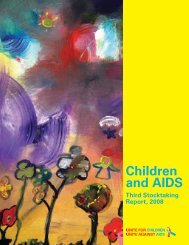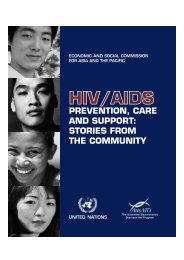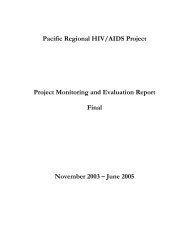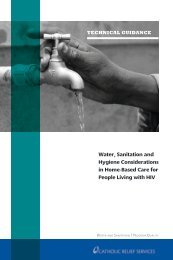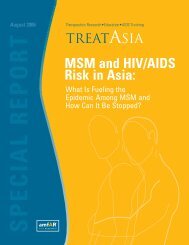Assessing HIV/AIDS Initiatives in China - Center for Strategic and ...
Assessing HIV/AIDS Initiatives in China - Center for Strategic and ...
Assessing HIV/AIDS Initiatives in China - Center for Strategic and ...
You also want an ePaper? Increase the reach of your titles
YUMPU automatically turns print PDFs into web optimized ePapers that Google loves.
Bates Gill 11<br />
stra<strong>in</strong>ed, reduc<strong>in</strong>g long-term chances <strong>for</strong> success. Additionally, many smaller projects are<br />
unable to effectively address the broader challenges that are faced by the populations they<br />
serve.<br />
A newer concept <strong>in</strong> the fight aga<strong>in</strong>st <strong>HIV</strong>/<strong>AIDS</strong> <strong>in</strong> Ch<strong>in</strong>a is the <strong>in</strong>troduction of publicprivate<br />
partnerships. These ef<strong>for</strong>ts seek to jo<strong>in</strong> the talents <strong>and</strong> resources of private<br />
entities, such as a bus<strong>in</strong>ess, with the central <strong>and</strong> local government authorities. Groups<br />
such as the Global Bus<strong>in</strong>ess Coalition on <strong>HIV</strong>/<strong>AIDS</strong> have been active <strong>in</strong> promot<strong>in</strong>g such<br />
<strong>in</strong>itiatives. The concept, which is somewhat contrary to Ch<strong>in</strong>ese development aid<br />
practices <strong>in</strong> the past, is slowly catch<strong>in</strong>g on but will take time to be fully understood <strong>and</strong><br />
leveraged as Ch<strong>in</strong>ese government <strong>and</strong> private-sector actors work out their respective roles<br />
<strong>and</strong> responsibilities with<strong>in</strong> such a framework.<br />
Drug Resistance<br />
As of June 2005, the head of the national <strong>HIV</strong>-treatment program claimed that some<br />
20,453 <strong>HIV</strong>-positive persons were enrolled <strong>in</strong> the national drug treatment program known<br />
as Ch<strong>in</strong>a CARES. A number of difficulties attend this program, however. The Ch<strong>in</strong>a<br />
CARES program <strong>in</strong>itially <strong>in</strong>troduced a first-l<strong>in</strong>e drug therapy that is poorly tolerated by<br />
patients, is difficult to adhere to, <strong>in</strong>duces serious toxic side effects, <strong>and</strong> <strong>in</strong> the end is not<br />
as effective aga<strong>in</strong>st the virus as other first-l<strong>in</strong>e therapies used elsewhere <strong>in</strong> the world. The<br />
pr<strong>in</strong>cipal reason Ch<strong>in</strong>a CARES chose this particular regimen—either AZT + ddI +<br />
neverap<strong>in</strong>e or AZT + d4T + neverap<strong>in</strong>e—is because these drugs are produced as generics<br />
<strong>in</strong> Ch<strong>in</strong>a. Beg<strong>in</strong>n<strong>in</strong>g <strong>in</strong> early 2005, Ch<strong>in</strong>a CARES <strong>in</strong>troduced more effective anti-<strong>HIV</strong><br />
compounds purchased from abroad <strong>in</strong>to the first-l<strong>in</strong>e therapy: 3TC <strong>and</strong> efavirenz.<br />
Accord<strong>in</strong>g to the head of the Ch<strong>in</strong>a CARES program <strong>in</strong> mid-2005, about 20 percent of<br />
enrollees received the more effective therapy, <strong>and</strong> he expects to <strong>in</strong>crease the use of 3TC<br />
<strong>and</strong> efavirenz <strong>in</strong> the future.<br />
Data presented <strong>in</strong> late August 2005 <strong>in</strong> Beij<strong>in</strong>g by Ch<strong>in</strong>ese <strong>HIV</strong> doctors show that on<br />
average, between 45 <strong>and</strong> 80 percent of patients treated beg<strong>in</strong> to harbor a resistant virus<br />
<strong>and</strong> start to fail. In other sett<strong>in</strong>gs, <strong>and</strong> especially <strong>in</strong> the West, when a patient beg<strong>in</strong>s to<br />
fail, the treatment is adjusted to a second-l<strong>in</strong>e therapy aga<strong>in</strong>st which the virus is not<br />
resistant, <strong>in</strong> order to drive the viral load back down aga<strong>in</strong>. As of early 2006, Ch<strong>in</strong>a did not<br />
have a second-l<strong>in</strong>e therapy under the Ch<strong>in</strong>a CARES program. Once a Ch<strong>in</strong>a CARES<br />
patient has a resistant virus, there are no treatment alternatives with<strong>in</strong> its national<br />
treatment program.<br />
Ch<strong>in</strong>ese officials <strong>and</strong> medical experts have not seriously studied the social or political<br />
ramifications of widespread drug resistance <strong>and</strong> treatment failure under the Ch<strong>in</strong>a<br />
CARES program. It is important to note, however, that with just over 3 percent of<br />
suspected <strong>HIV</strong>-positive persons enrolled <strong>in</strong> the program, antiretroviral drugs are not<br />
available to the majority of those who may need them.<br />
Address<strong>in</strong>g the Needs of Marg<strong>in</strong>alized Groups<br />
Much of Ch<strong>in</strong>a’s <strong>HIV</strong>/<strong>AIDS</strong> challenge will arise from with<strong>in</strong> hard-to-access, at-risk<br />
groups that are socially <strong>and</strong> economically marg<strong>in</strong>alized. There is a great need to<br />
reorganize the national response <strong>in</strong> a way that more effectively addresses the needs of



